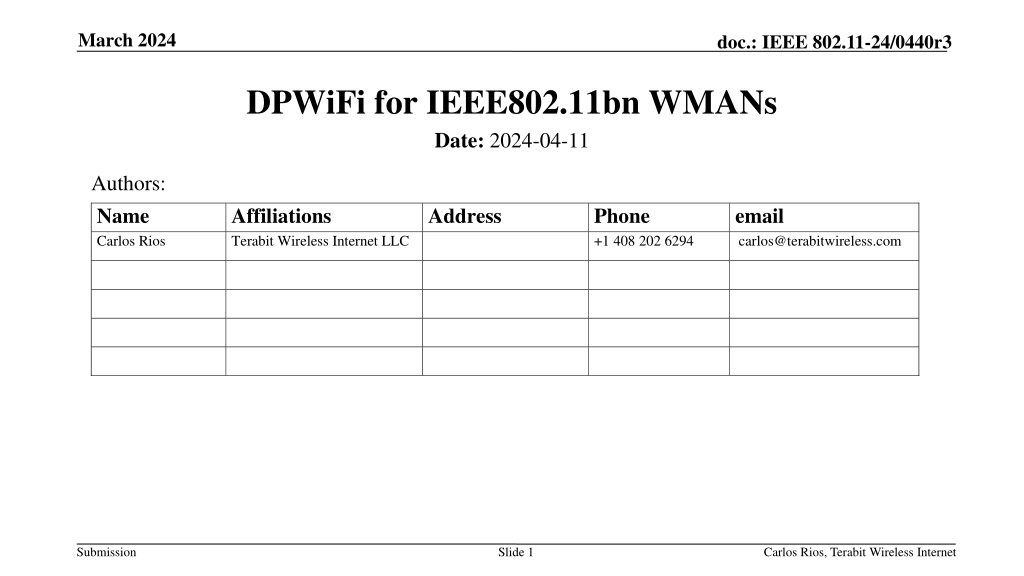

0 likes | 12 Views
TWI's DPWiFi, based on IEEE802.11bn, introduces breakthrough wireless technology for Wireless Metropolitan Area Networks (WMANs). The proposed DPWiFi IEEE802.11bn PHY/MAC specification includes advanced features like Dynamic Polarization Multiplexing, MIMO technology, interference cancellation, and more to enable transformative broadband services worldwide. The technology aims to revolutionize network connectivity with high-speed data rates and efficient network performance.

E N D
March 2024 doc.: IEEE 802.11-24/0440r3 DPWiFi for IEEE802.11bn WMANs Date: 2024-04-11 Authors: Name Carlos Rios Affiliations Terabit Wireless Internet LLC Address Phone +1 408 202 6294 email carlos@terabitwireless.com Submission Slide 1 Carlos Rios, Terabit Wireless Internet
March 2024 doc.: IEEE 802.11-24/0440r3 Abstract TWI’s proposed “DPWiFi” IEEE802.11bn PHY/ MAC, particularly relevant to Wireless Metropolitan Area Networks (“WMANs”), represents Breakthrough wireless enabling Disruptive radios forming Revolutionary networks to deliver Transformative Broadband worldwide in the not too distant future Submission Slide 2 Carlos Rios, Terabit Wireless Internet
March 2024 doc.: IEEE 802.11-24/0440r3 Proposed DPWiFi IEEE802.11bn PHY/ MAC Specification 32 IEEE802.11be concurrent, cochannel EHT RF streams 32x32 MIMO Dynamic Polarization Multiplexing 32x32 MIMO Tx/Rx DLOS/ nLOS/ NLOS Beam Forming/ Steering Propagation Channel Impairment Mitigation AP/ Client Rx Interference Cancellation AP Tx Multi-beaming Client Rx Multipath Recombination 90D/ 10U TDMA MAC 5-7 GHz UNII Operation Submission Slide 3 Carlos Rios, Terabit Wireless Internet
March 2024 doc.: IEEE 802.11-24/0440r3 Breakthrough DPWiFi Technology • The WMAN DP propagation channel [HDP] is an n-dimensional “Polarization Space” The upper bound for n, if it exists, greatly exceeds 32 • The [HDP] channel transfer function is non-singular, deterministic, scalar and uniform • I.e., hij = 1, i = j; hij = 0 ≤ r < 1, i ≠ j • The Propagation Channel Dynamic Polarization Index (ChDPI) “r” varies with [HDP] impairments • DPWiFi DLOS, nLOS and NLOS links are subject to [HDP] “depolarization” (i.e., induced Rx angular polarization rotation wrt Tx-established orthogonality baseline) • DLOS links experience atmospheric fog, rain, etc. of up to 5o[HDP] depolarization • nLOS links obstructed/ diffracted by foliage or structures face up to 15odepolarization • NLOS links reflected by structures or vehicles depolarize by up to 45o Submission Slide 4 Carlos Rios, Terabit Wireless Internet
March 2024 doc.: IEEE 802.11-24/0440r3 Breakthrough DPWiFi Chipsets Submission Slide 5 Carlos Rios, Terabit Wireless Internet
March 2024 doc.: IEEE 802.11-24/0440r3 Disruptive DPWiFi APs and Clients • DPWiFi Backhaul (“DPBH”): High Directivity 184/ 553/ 1106 Gbps AP/ Meshnode • DPWiFi Base Station (“DPBS”): Wide Coverage 184 Gbps AP • DPWiFi CPE (“DPC”): High Directivity 5.8 Gbps Client Submission Slide 6 Carlos Rios, Terabit Wireless Internet
March 2024 doc.: IEEE 802.11-24/0440r3 Revolutionary DPWiFi Networks DPWiFi Backhaul One DPBH Backhaul link transports 184/ 553/ 1106 Gbps beyond 25 km DPWiFi Distribution • “Metropolitan DPWiFi” for densest population cities • “Municipal DPWiFi” for sparser population cities • “Rural DPWiFi” for lightly populated regions One DPWiFi Distribution network supplies dedicated 4kHD to • 60k subscribers within 3 km, or • 40k subscribers within 6 km, or • 20k subscribers within 14 km Submission Slide 7 Carlos Rios, Terabit Wireless Internet
March 2024 doc.: IEEE 802.11-24/0440r3 Transformative “Fixed WiFi Access” Rural WMANs Rural “FWiFiA”: 184 Gbps Base Station/ Up to 20k Subscribers up to 14 km away Rural DPWiFi 90% Gross Margin BLOWS UP today’s Exurban FWA Business Model Submission Slide 8 Carlos Rios, Terabit Wireless Internet
March 2024 doc.: IEEE 802.11-24/0440r3 Transformative Fixed WiFi Access Urban WMANs Metro FWiFiA: 1.1 Tbps Base Station/ Up to 300k Subscribers per 3km radius city cell Metro DPWiFi 97% Gross Margin BLOWS UP today’s Urban FWA Business Model Submission Slide 9 Carlos Rios, Terabit Wireless Internet
March 2024 doc.: IEEE 802.11-24/0440r3 What’s to Become of DPWiFi WMANs? • There are ~1.4B Fixed Broadband (“FBB”) connections worldwide today • ~ 72.8% Fiber (FTTx) • ~ 16.0% Cable (Mostly USA-CN DOCSIS) • ~ 8.7% Copper (DSL, ADSL, VDSL) • More About that North American Fixed Wireless Access • ~3k WISPs are vying to BB-connect ~12k communities (500-50k residents) with $50-100/mo HD And achieve a 1 – 5% penetration of ~60% (~80M households) of the USA-Canada population • $10/mo 60/60/24/7 Dedicated 4kHD Rural FWiFiA would capture practically ALL those households • This means ~80M DPWiFi CPEs ultimately deployed, or ~40M DPCs sold annually For a $800M SoC/ $4B CPE annual business in as little as 3 years • Fixed WiFi Access will completely upend the above Global Broadband Order • Global FBB incumbent NWOs will overbuild their own urban networks with Metro/ Muni FWiFiA • Those same incumbents then expand into the neighboring countryside with Rural FWiFiA • All those FWiFiA networks combine to offer $10/mo 60/60/24/7 4kHD to up to 2B global subs by 2029 And don’t forget many subs will also drive connected cars by then, accounting for ~ 500M more connections • This means ~2.5B DPWiFi CPEs deployed, or ~1.25B DPCs sold yearly Or a $25B SoC/ $125B CPE yearly business by 2030 DPWiFi WMANs will Displace Legacy Fixed Broadband! Submission Slide 10 Carlos Rios, Terabit Wireless Internet
March 2024 doc.: IEEE 802.11-24/0440r3 References 1. 23/1606r1-UHRSG Dynamic Polarization Multiplexing and Beamforming WLANs Carlos A Rios (Terabit Wireless Internet), 13-Sep-2023 2. 23/1756r3-TGbn MIMO Dynamic Polarization and Beamforming: Proposed IEEE802.11bn PHY Carlos A Rios (Terabit Wireless Internet), 16-Nov-2023 3. 24/0041r12-TGbn DPWiFi MATLAB Validation Carlos A Rios (Terabit Wireless Internet), 02-Feb-2024 Submission Slide 11 Carlos Rios, Terabit Wireless Internet